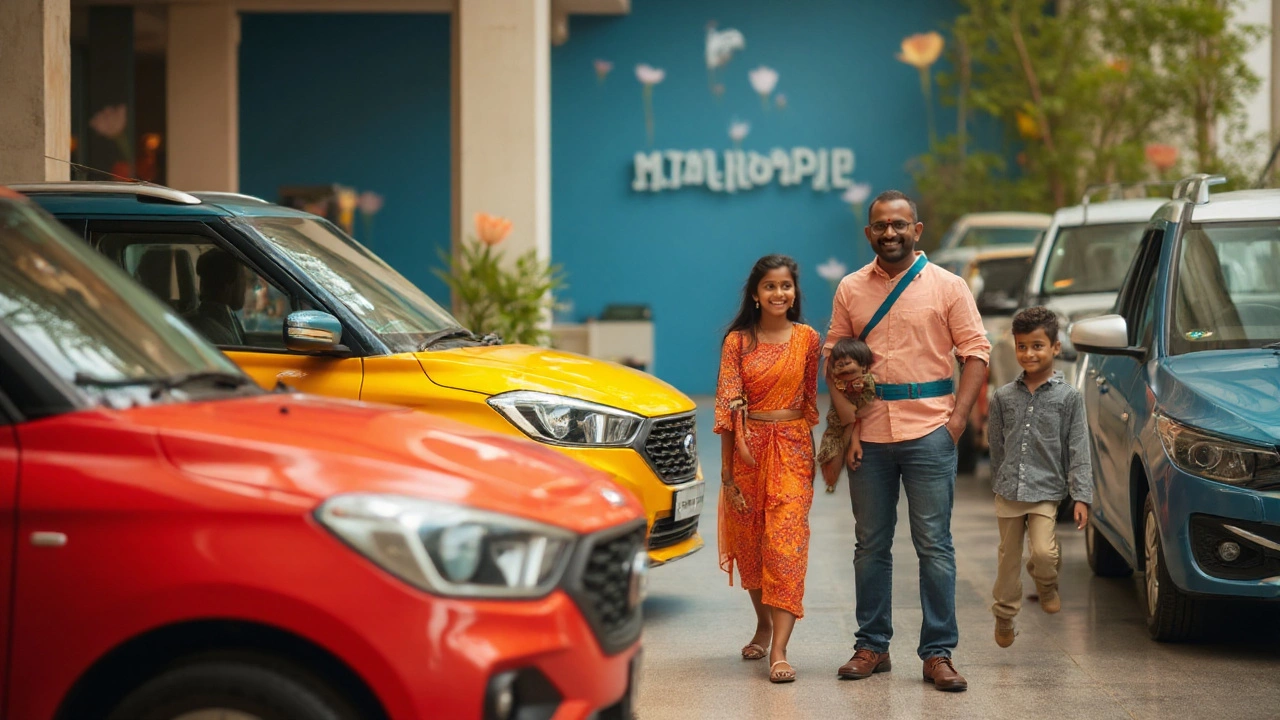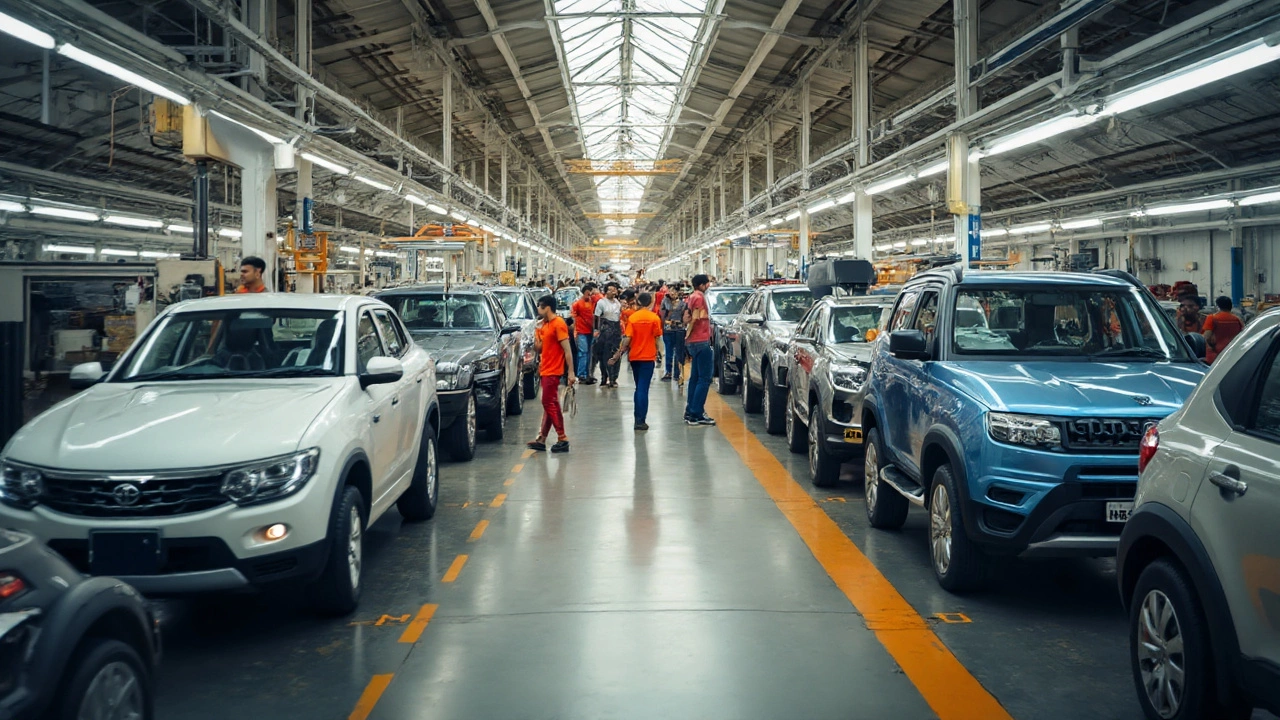Indian ownership of car brands isn’t just about badge stickers or stickers with a tiny Indian flag. It’s about global influence, engineering muscle, and sometimes, a surprising splash of pride. Ever wondered if India actually owns any true-blue car brands, or if it’s all just foreign players assembling vehicles on Indian soil? Here’s a reality check: not only does India have car brands of its own, but some of these companies own legendary names abroad. That's sort of like beating the foreign teams at their own game—and then hiring them to play for your side.
The Titans: Tata Motors, Mahindra, and Beyond
Let’s cut straight to the big two: Tata Motors and Mahindra & Mahindra. These guys aren’t just making cars for local buddies looking for mileage—they’ve gone global, swallowing up iconic Western brands, investing in electric cars, and pushing ‘Made in India’ further than anyone expected. Now, Tata Motors is probably the most famous homegrown success story. Started in 1945, Tata Motors is the jewel in the Tata Group’s hefty industrial crown. If you spot a Jaguar or a Land Rover whizzing by in London or Dubai, yep, that's Tata's handiwork behind the curtains. Back in 2008, this Indian company acquired Jaguar and Land Rover from Ford for about $2.3 billion. It’s a deal people still talk about in boardrooms across auto capitals; when the British media first heard about it, jaws literally dropped. Tata transformed the struggling luxury duo, kept their British flair, and sprinkled in Indian ambition and efficiency—turning them profitable faster than most expected.
How did Tata do it? Simple answer: trust and investment. They left British employees in charge of design and engineering, while Tata's steady hand kept the cash flowing. The result? Jaguar Land Rover’s sales in 2022 hit over 431,000 vehicles globally. Tata operates every part of the chain, from design studios in the UK to booming production lines in Pune. The company also builds everything from tiny city cars like the now-discontinued Nano to full-blooded SUVs, trucks, and even buses. Tata’s homegrown cars, like the Nexon and Altroz, are known for scoring high safety ratings in crash tests. In fact, the Tata Nexon was the first Indian car to win a 5-star Global NCAP safety rating, something that made even safety-conscious Germans sit up and notice.
Then there’s Mahindra & Mahindra. Started off making Willys Jeeps under license after World War II, now this brand is known for its muscular SUVs like the Scorpio and Thar, and even for owning foreign badge Mahindra SsangYong (a South Korean company, though Mahindra has since reduced their stake). But here’s a fun twist: Mahindra isn’t just about cars. They are the world’s largest tractor maker by volume—that’s right, larger than John Deere globally. They’ve got their hands in electric vehicles, two-wheelers, and even started selling their off-road Roxor in America. In 2015, they bought the Italian car design firm Pininfarina, famous for styling Ferraris. Ever seen a Ferrari and an Indian SUV breathe the same design air? Weird, but it works.
Is that the full list? Not quite. Force Motors (builders of sturdy utility vehicles and engines for luxury brands like BMW in India), Ashok Leyland (giant in buses and commercial trucks), Eicher Motors (parent company of Royal Enfield, and joint ventures with Volvo in trucks) all fly the Indian flag—even if they’re not exactly household names for passenger cars. These players shape much of what moves on Indian roads, and their quiet influence bleeds into international markets.
Just for the stat lovers, here’s a quick view:
| Brand | Owned By | Notable Acquisitions / Products | Global Reach |
|---|---|---|---|
| Tata Motors | India (Tata Group) | Jaguar, Land Rover, Tata Nexon | Worldwide |
| Mahindra & Mahindra | India (Mahindra Group) | Thar, Scorpio, SsangYong (ex), Roxor, Pininfarina | Asia, Africa, US, Europe (Pininfarina) |
| Ashok Leyland | India (Hinduja Group) | Buses, Trucks | Asia, Africa, Middle East |
| Force Motors | India (Firodia Group) | Traveller, Gurkha, BMW engines (India) | Mostly India, Africa |
| Eicher Motors | India | Royal Enfield, VE Commercial Vehicles | Asia, Europe, US (motorcycles) |
So, if anybody tells you India doesn’t build or own car brands, you know they’re off by a country mile.

The Global Game: How Indian Companies Became International Players
Here’s where things get interesting. In the early 2000s, nobody looked at India and thought ‘automotive superpower’. Indian cars had a clunky, basic image—reliable maybe, but nothing to get excited about. Yet, relax for a second and take in the headlines today: Indian brands owning luxury British badges, exporting zero-emission buses to Europe, buying Italian design houses, and dabbling in all-electric SUVs. It didn’t happen overnight. So, how did this shift go down?
Low-cost manufacturing gave Indian companies a head start. Labor’s cheaper, engineering talent is deep, and the home market is obsessed with both price and value. But more than just ‘cheap and cheerful’, Indian brands started going after quality and international standards. Tata’s takeover of Jaguar Land Rover was just the first of many bold steps. Mahindra entered the US market not with mainstream SUVs, but with off-road vehicles and electric mobility companies like GenZe (though GenZe later closed shop in 2020). Both Tata and Mahindra poured money into R&D centers in Europe and the US—this wasn’t just brain drain in reverse, but brain gain. They picked up the best from around the world and remixed it with Indian ingenuity.
Regulations also forced Indian manufacturers to up their safety and emissions game. The older image of Indian cars flunking crash tests started fading away. Homegrown Tata cars like the Punch and Altroz smashed safety ratings, sending a message abroad. Meanwhile, Mahindra’s investment in Formula E put them on the electric world motorsport map—which, honestly, nobody saw coming just a decade ago. Even Ashok Leyland is making electric buses and trucks now, chasing clean urban mobility contracts from London to Dubai. The practical upshot? If you grab an Uber in Johannesburg or Lagos, chances are it might be a Tata or Mahindra vehicle rolling up.
Here’s a quick-fire timeline of major moments:
- 2008: Tata Motors snaps up Jaguar Land Rover from Ford for $2.3 billion.
- 2010: Mahindra takes control of South Korea’s SsangYong Motor Company.
- 2015: Mahindra acquires Pininfarina, Italian design house famous for Ferraris and Maseratis.
- 2018-2019: Tata launches the Harrier and Altroz; Nexon gets 5-star Global NCAP rating.
- 2022: Tata Nexon EV becomes a bestseller, leading India’s EV segment.
- 2023: Tata’s JLR division reports more than 431,000 sales worldwide, raking in over £22 billion in revenue.
Even when the rest of the world started tightening their borders and markets got hostile during COVID-19, Indian car companies weathered the storm. Tata and Mahindra adapted fast—localizing supply chains, keeping costs under control, and taking bold digital moves (like launching cars with ‘Click to Drive’ portals). It helped them bounce back quicker than some Western rivals, scoring points with investors and customers alike.
What makes Indian cars tick abroad? Reliability, value, and, increasingly, safety. Even the old joke about Indian ‘jugaad’ (the art of finding low-tech fixes) has evolved. Now, it’s more about frugal engineering—squeezing creative solutions out of a rupee. A great example is Tata’s ability to make compact SUVs loaded with tech but still keep the sticker price under check. Mahindra’s Thar is now a lifestyle badge in South Africa and Australia, not just an ‘affordable 4x4’. Who would've guessed?
Not all attempts worked out—Mahindra’s Korean adventure with SsangYong didn’t quite pan out, with stakes being reduced by 2022 due to financial trouble in Korea. But the broader story stands: Indian brands are definitely playing in the world league, not just running a local match.

Tips for Spotting and Buying an India-Owned Car Brand
If you’re out shopping for a car—either in India, or abroad—and wonder if you’re looking at an India-owned brand, here’s how to get smart about it. Start by looking for ownership. Just because a car is made in India (think: huge Hyundai and Suzuki factories) doesn’t mean it’s an Indian brand. Many global giants have ‘Make in India’ tags, but their corporate headquarters, decision makers, and profits still end up elsewhere.
If you want a true Indian ownership story, stick with brands like Tata, Mahindra, Force, Ashok Leyland, Eicher, and sometimes Bajaj (mainly for two-wheelers, though they’ve dabbled in small cars). Tata-branded cars in showrooms worldwide are made, managed, and owned by an Indian company—even if they look British or European. Mahindra’s SUVs, pickups, and the quirky Reva e2o (once one of the earliest practical EVs in India) are all homegrown stories. By contrast, brands like Maruti Suzuki are technically Japanese-owned, even though they build almost entirely for the Indian market.
Look for safety ratings, too. Modern Tata cars routinely get 4 or 5 stars in the independent Global NCAP crash tests. Mahindra’s XUV300 and XUV700 have also scored impressively for safety. Want eco-friendly? Tata’s Nexon EV, Tiago EV, and upcoming electric SUVs are leading India’s electric boom. Mahindra’s recently-launched XUV400 EV aims for the same pie, and their Treo electric three-wheeler rickshaws are helping clean up city air. These are not just knockoff copies or budget choices—they’re pushing new tech at a surprising pace.
Here’s what else to watch for if you’re considering an India-owned car:
- Indian car brands often build to last under tough conditions—think hot summers and rough roads. That means global buyers in Africa, Latin America, and Southeast Asia trust them for value and resilience.
- Servicing and spares are cheaper since parts are locally sourced and abundant.
- Look up the car’s history. For example, did you know Royal Enfield bikes—now icons in the US and UK—are part of Eicher Motors in India?
- Bolt-on tech: Tata and Mahindra models now come with digital dashboards, connected car features, and surprisingly plush interiors for the price point.
- Buying pre-owned? Depreciation on Indian brands tends to be slower thanks to their utilitarian value, but always check for rust and rough use, especially on workhorses like Mahindra pickups.
- Don’t confuse OEM production (where Indian makers build for brands like Mercedes, BMW, or Ford under contract) with brand ownership. That distinction matters for pride and support.
For the auto-curious, here’s a pro tip: follow the money. Corporate annual reports and auto expo news are great for spotting who owns what. Tata’s annual reports spell out profits and investments from Jaguar Land Rover, while Mahindra details every new acquisition or divestment. In a world where ‘Buy Local’ is catching on, knowing which brands are truly Indian-owned can give you more confidence on the road—and probably a few bragging rights at the next dinner party.
So what’s next for Indian car brands? All eyes are on the electric revolution. Tata is pouring billions into EVs and battery tech, Mahindra is not far behind, and new service models—like digital-only car deals—are being piloted in metros. With the world shifting towards decarbonization, Indian makers have the scale, smarts, and growing R&D muscle to challenge the giants. Next time someone asks ‘Which car brand is owned by India?’—you’ll have a lot more to say than just ‘Tata’. India is quietly, but confidently, driving the future.
